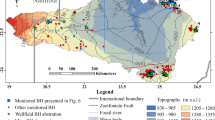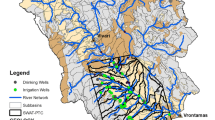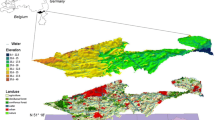Abstract
Riparian groundwater evapotranspiration (ETg) constitutes a major component of the water balance especially in many arid and semi-arid environments. Although spatial and temporal variability of riparian ETg are controlled by climate, vegetation and subsurface characteristics, depth to water table (DTWT) is often considered the major controlling factor. Relationships between ETg rates and DTWT, referred to as ETg curves, are implemented in MODFLOW ETg packages (EVT, ETS1 and RIP-ET) with different functional forms. Here, the sensitivity of the groundwater budget in MODFLOW groundwater models to ETg parameters (including ETg curves, land-surface elevation and ETg seasonality) are investigated. A MODFLOW model of the hypothetical Dry Alkaline Valley in the Southwestern USA is used to show how spatial representation of riparian vegetation and digital elevation model (DEM) processing methods impact the water budget when RIPGIS-NET (a GIS-based ETg program) is used with MODFLOW’s RIP-ET package, and results are compared with the EVT and ETS1 packages. Results show considerable impact on ETg and other groundwater budget components caused by spatial representation of riparian vegetation, vegetation type, fractional coverage areas and land-surface elevation. RIPGIS-NET enhances ETg estimation in MODFLOW by incorporating vegetation and land-surface parameters, providing a tool for ecohydrology studies, riparian ecosystem management and stream restoration.
Résumé
L’évapotranspiration rivulaire (ETg) constitue une composante majeure du bilan hydrique particulièrement dans de nombreux environnements arides et semi-arides. Bien que la variabilité spatiale et temporelle de l’ETg rivulaire soit contrôlée par le climat, par la végétation et par les caractéristiques de subsurface, la profondeur de nappe (DTWT) est souvent considérée comme le principal facteur de contrôle. Les relations entre les taux ETg et DTWT, rapportés aux courbes ETg, sont entrées dans les packages MODFLOW ETg (EVT, ETS1 et RIP-ET) sous différentes formes fonctionnelles. De cette façon, on étudie la sensibilité du bilan de nappe MODFLOW aux paramètres ETg (incluant courbes ETg, cote du terrain et saisonnalité ETg). Un modèle MODFLOW de la Dry Alkaline Valley, Sud-Ouest des USA, est utilisé pour montrer comment la représentation spatiale de la végétation rivulaire et les méthodes de traitement (DEM) du modèle numérique de terrain impactent le bilan hydrique quand RIPGIS-NET (un program ETg basé sur GIS) est utilisé avec le package MODFLOW RIP-ET, puis les résultats sont comparés avec les packages EVT et ETS1. Les résultats montrent l’impact considérable de la représentation spatiale de la végétation rivulaire, type de végétation, distribution, relief, sur l’ETg et sur d’autres composantes du bilan hydrique. RIPGIS-NET amplifie l’estimation ETg de MODFLOW en incorporant les paramètres végétation et surface du sol, fournissant un outil pour des études d’écohydrologie, gestion d’écosystème rivulaire et restauration de cours d’eau.
Resumen
La evapotranspiración ripariana del agua subterránea (ETg) constituye un componente principal del balance de agua especialmente en muchos ambientes áridos y semiáridos. Aunque la variabilidad espacial y temporal de la ETg ripariana está controlada por el clima, la vegetación y las características subsuperficiales, la profundidad del nivel freático (DTWT) es a menudo considerado el mayor factor de control. Se implementaron las relaciones entre los ritmos de ETg y DTWT, referidas como curvas de ETg, en los paquetes de ETg de MODFLOW (EVT, ETS1 y RIP-ET) con formas funcionales diferentes. Se investigaron aquí, la sensibilidad del balance de agua subterránea en los modelos de agua subterránea MODFLOW a los parámetros ETg (incluyendo curvas ETg, elevación de la superficie del terreno y estacionalidad de ETg). Se usó un modelo MODFLOW del hipotético Dry Alkaline Valley en el sudoeste de EEUU para mostrar como la representación espacial de la vegetación ripariana y los métodos de procesamiento del modelo digital de elevación (DEM) impactan el balance de agua cuando se utiliza el RIPGIS-NET (un GIS basado en el programa ETg) con el paquete MODFLOW’s RIP-ET, y los resultados son comparados con los paquetes de EVT y ETS1. Los resultados muestran un impacto considerable sobre la ETg y otros componentes del balance del agua subterránea provocado por la representación espacial de la vegetación ripariana, el tipo de vegetación, la fracción de áreas cubiertas y las elevaciones de la superficie del terreno. RIPGIS-NET mejora la estimación de ETg en MODFLOW incorporando los parámetros de la vegetación y de la superficie del terreno, proporcionando una herramienta para estudios ecohidrológicos, manejo de ecosistemas riparianos y restauración de corrientes.
摘要
河岸带地下水的腾发 (ETg) 在水量平衡中起重要作用,特别是在许多干旱半干旱地区。河岸带腾发存在空间和时间上的差异,影响因素包括:气候、植被和地面以下各种指标,这其中地下水埋深 (DTWT) 被认为是最重要的一个控制因素。腾发(ETg)速率和地下水位埋深(DTWT)的关系用ETg曲线表示。利用ETg程序包(EVT, ETS1和 RIP-ET),在MODFLOW不同的功能形式下即可绘制。本文探讨了MODFLOW地下水模型中水量平衡对腾发参数(包括腾发曲线,地面高程,季节性腾发)的灵敏性。在虚拟的美国西南部碱性干谷地带联合利用RIPGIS-NET (基于 GIS的 ETg 程序)与 MODFLOW的 RIP-ET 包,目的以阐明不同的河岸带植被的空间分布和地面数字高程模型(DEM)处理方法是如何影响水量平衡的,并将该将结果和EVT 和ETS1 包处理的结果进行对比。结果表明河岸带植被的空间分布,植被类型,植被覆盖率和地面高程都对腾发量及其它地下水水量均衡因子存在一定的影响。综合考虑植被和地面参数后,加载了RIPGIS-NET程序包的MODFLOW提高了腾发量估算精度,为生态水文研究、河岸带生态系统管理和河流恢复工程提供支撑。
Resumo
A evapotranspiração ripária a partir da água subterrânea (ETg) constitui uma componente principal do balanço hídrico, especialmente em muitos ambientes áridos e semi-áridos. Apesar da variabilidade espacial e temporal da ETg ripária ser controlada pelo clima, pela vegetação e pelas características subsuperficiais, considera-se ser a profundidade a que se encontra a superfície freática (DTWT) o principal factor de controlo. As relações entre os graus de ETg e as curvas de DTWT, conhecidas como curvas de ETg, são implementadas nos pacotes de ETg no MODFLOW (EVT, ETS1 e RIP-ET) com diferentes formas funcionais. Neste trabalho foi investigada a sensibilidade do balanço hídrico subterrâneo em modelos de escoamento subterrâneo MODFLOW aos parâmetros ETg (incluindo as curvas ETg, a altura da superfície do terreno e a sazonalidade da ETg). Foi usado um modelo MODFLOW do hipotético Dry Alkaline Valley, no sudoeste dos EUA, para mostrar como os métodos de processamento das representações espaciais da vegetação ripária e dos modelos digitais de terreno (DEM) influenciam o balanço hídrico quando se usa o RIPGIS-NET (um programa de ETg baseado em SIG) com o pacote RIP-ET do MODFLOW, sendo os resultados comparados com os dos pacotes EVT e ETS1. Os resultados mostram impacte considerável na ETg e noutros componentes do balanço hídrico subterrâneo, causado pelas representações espaciais da vegetação ripária, do tipo de vegetação, das áreas de cobertura relativa e da altura da superfície do terreno. O RIPGIS-NET melhora a estima da ETg no MODFLOW, ao incorporar parâmetros da vegetação e da superfície do terreno, proporcionando uma ferramenta para estudos de eco-hidrologia, gestão de ecossistemas ripários e restauro fluvial.






Similar content being viewed by others
References
Ajami H, Maddock T (2009) RIPGIS-NET: an ArcGIS custom application for the RIP-ET package in MODFLOW-2000 and MODFLOW-2005. HWR Report no. 10-010. Department of Hydrology and Water Resources, University of Arizona, Tucson, 247 pp
Ajami H, Maddock T, Meixner T, Hogan JF, Guertin DP (2011) RIPGIS-NET: a GIS Tool for riparian groundwater evapotranspiration in MODFLOW. Ground Water. doi:10.1111/j.1745-6584.2011.00809.x
Baird KJ, Maddock T (2005) Simulating riparian evapotranspiration: a new methodology and application for groundwater models. J Hydrol 312(1–4):176–190
Baird KJ, Stromberg JC, Maddock T (2005) Linking riparian dynamics and groundwater: an ecohydrologic approach to modeling groundwater and riparian vegetation. Environ Manage 36(4):551–564
Banta ER (2000) MODFLOW-2000, The U.S. Geological Survey modular ground-water model-Documentation of packages for simulating evapotranspiration with a segmented function (ETS1) and drains with return flow (DRT1). US Geol Surv Open-File Rep 00-466, 131 pp
Hanson RT, Newhouse MW, Dettinger MD (2004) A methodology to assess relations between climatic variability and variations in hydrologic time series in the Southwestern United States. J Hydrol 287(1–4):252–269
Harbaugh AW (2005) MODFLOW-2005, the U.S. Geological Survey modular ground-water model: the ground-water flow process. US Geol Surv Techniques and Methods 6-A16, 253 pp
Harbaugh AW, Banta ER, Hill MC, McDonald MG (2000) MODFLOW-2000, the U.S. Geological Survey modular ground-water model: user guide to modularization concepts and the ground-water flow process. US Geol Surv Open-File Report 00-92, 121 pp
Kuniansky EL, Lowery MA, Campbell BG (2009) How processing digital elevation models can affect simulated water budgets. Ground Water 47(1):97–107
Lavorel S, McIntyre S, Landsberg J, Forbes TDA (1997) Plant functional classifications: from general groups to specific groups based on response to disturbance. Tree 12:474–478
Leake SA, Reeves HW, Dickinson JE (2010) A new capture fraction method to map how pumpage affects surface water flow. Ground Water 48(5):690–700
Lubczynski MW (2009) The hydrogeological role of trees in water-limited environments. Hydrogeol J 17(1):247–259
Lubczynski MW, Gurwin J (2005) Integration of various data sources for transient groundwater modeling with spatio-temporally variable fluxes: Sardon study case, Spain. J Hydrol 306(1–4):71–96
Maddock III T, Baird KJ (2003) A riparian evapotranspiration package for MODFLOW-96 and MODFLOW-2000. HWR Report no. 02-03. Department of Hydrology and Water Resources, University of Arizona Research Laboratory for Riparian Studies, University of Arizona, Tucson, AZ
Maddock T III, Vionnet LB (1998) Groundwater capture processes under a seasonal variation in natural recharge and discharge. Hydrogeol J 6(1):24–32
McDonald MG, Harbaugh AW (1988) A modular three-dimensional finite-difference ground-water flow model. US Geol Surv Open-File Rep 83-875, 588 pp
Naumburg E, Mata-Gonzalez R, Hunter RG et al (2005) Phreatophytic vegetation and groundwater fluctuations: a review of current research and application of ecosystem response modeling with an emphasis on Great Basin vegetation. Environ Manage 35(6):726–740
Scott RL, Cable WL, Huxman TE et al (2008) Multiyear riparian evapotranspiration and groundwater use for a semiarid watershed. J Arid Environ 72(7):1232–1246
Shah N, Nachabe M, Ross M (2007) Extinction depth and evapotranspiration from ground water under selected land covers. Ground Water 45(3):329–338
Williams DG, Scott RL, Huxman TE et al (2006) Sensitivity of riparian ecosystems in arid and semiarid environments to moisture pulses. Hydrol Process 20(15):3191–3205
Yeh PJF, Famiglietti JS (2009) Regional groundwater evapotranspiration in Illinois. J Hydrometeorol 10(2):464–478
Acknowledgements
This research was supported by the US Environmental Protection Agency STAR grant (R833025), by SAHRA (Sustainability of semi-Arid Hydrology and Riparian Areas) under the STC Program of the National Science Foundation, Agreement No. EAR-9876800, and the John and Margaret Harshbarger Doctoral Fellowship in subsurface hydrology-hydrogeology. We would like to thank David Prudic, Eve Kuniansky and an anonymous reviewer for their valuable comments on the manuscript.
Author information
Authors and Affiliations
Corresponding author
Rights and permissions
About this article
Cite this article
Ajami, H., Meixner, T., Maddock, T. et al. Impact of land-surface elevation and riparian evapotranspiration seasonality on groundwater budget in MODFLOW models. Hydrogeol J 19, 1181–1188 (2011). https://doi.org/10.1007/s10040-011-0743-0
Received:
Accepted:
Published:
Issue Date:
DOI: https://doi.org/10.1007/s10040-011-0743-0




